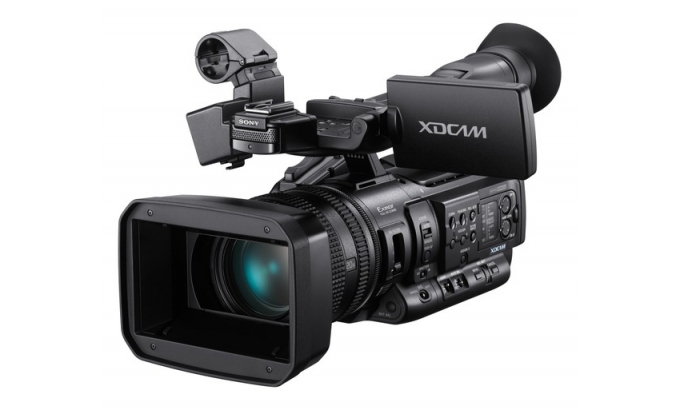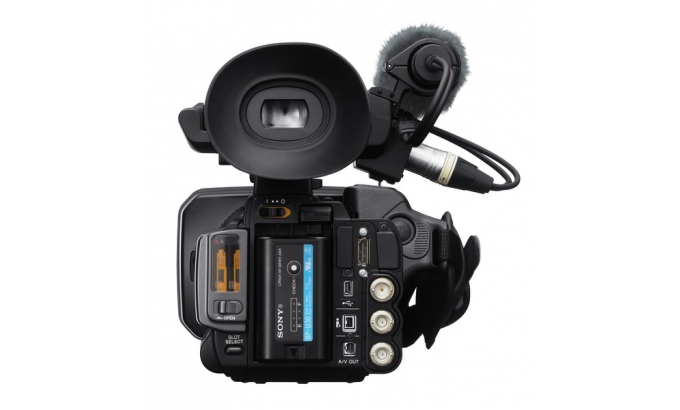Review: Sony PMW-150
(This is a guest review from Stephen Pritchard of AudioVideoPro.net)
It might seem odd to review a camera, when its manufacturer has openly stated it is due to be replaced. Sony has announced two new camcorders, the PXW-X180 and the PXW-X160, which sit in the territory currently occupied by the PMW-150. But for now, the Sony PMW-150 represents that company’s most affordable “broadcast” camcorder, and is a camera that still does much of what video makers will need – for both live and pre-recorded footage.

The PMW-150, is a three-chip, 1/3-inch sensor camcorder. This places it above the PMW-100 in Sony’s line-up but below the PMW-200 and PMW-300, which both feature half–inch chips. With camcorders, the larger the chip, the better the low-light performance, the cleaner the image and the more control the video maker has over depth of field.
Despite the fashion for large-format cameras, including DSLRs such as the Canon 5D or high-end, “cinematic” camcorders, the 1/3-inch camera is a mainstay of documentary and news filming, as well as corporate and events video. This is because a three-chip, 1/3-inch camcorder such as the PMW-150 offers a compromise between consumer camcorders – which usually have smaller sensors, or just a single sensor – and larger, heavier, and inevitably more expensive cameras for news or film making.
None the less the PMW-150 too is “broadcast standard” as it has those three chips and can record video at 50mbps and with 4:2:2 colour, meaning its footage will be accepted by most networks – should the need ever arise.
Note, though, that it can’t do this on cheap SD cards, only on Sony’s expensive SxS media or a XQD card via an adapter. Recording on SD cards is limited to 35mbps and 4:2:0, although this still produces good footage.
The PMW-150 is very similar in appearance to both Sony’s PMW-200 and indeed its earlier tape-based cameras such as the Z1, although it does lack the Z1’s tank-like build quality; the two cameras are almost identical in size, and boast very similar connectivity.
As a pro model, the PMW-150 range, has the full range of connectivity including genlock, timecode in/out, HD-SDI out and HDMI, and two channels of XLR audio. It also has a built-in neutral density (ND) filter.

The PMW-150 features a Sony G lens, with separate aperture, focus and zoom rings, although these are of the servo (electrical) type. The lens has a 20x zoom, which, which is a good range to have available. The camera starts with a 29.5mm field of view at the wide end and goes up to the equivalent of a 576mm lens on a 35mm camera. This is a longer range than, say, on Sony’s costlier PMW-200 camera, and longer than those on “large sensor” camcorders such as Sony’s FS-100 – or indeed on a DSLR’s kit lens.
The lens is also decently bright, at f1.6 at the wide end and the widest aperture. It’s not, though, a constant aperture lens: shots will darken as you zoom in, although this can be avoided by “stopping down” to a narrow aperture.
The f1.6 lens won’t, though, give that creamy background effect or bokeh that can be achieved on a camera such as the Panasonic GH4 or a Canon 5D. As the PMW-150 has a small sensor, much more of the picture is sharp even at the lens’ widest aperture. It is, though, possible to create background blur by careful positioning of subjects and especially, using the telephoto end of the zoom.
The plus size is this makes it easier to ensure sharp focus, albeit at the expense of a more “video” look. And it lets Sony fit that superzoom range into a portable camera that weighs just 2.5kg.
Putting the PMW-150 to work
The image quality on this camcorder is good, although the camera’s automatic aperture and white balance settings are not especially accurate; since our tests Sony has released firmware updates improving some of the internal settings. Manual settings produce a much better image straight from the camera.
The picture is though, perhaps less good than on some competing cameras with a similar spec, such as the JVC GY-HM650. In recent tests, the European Broadcasting Union rated the JVC ahead of the Sony. But in practice most video producers would be hard-pressed to spot much of a difference, unless they are filming in low light, where as a “standard” camcorder, with 1/3 inch chips, will never be spectacular.
In the field, the PMW-150 is a pleasant camera to use. Anyone who has used Sony cameras like the EX1 or Z1 will be at home with the camera, and the size and weight feel right for the tasks it is likely to perform.
There are no real ergonomic issues with this camera, and it feels designed for regular use in pressured environments such as news or live events. Everything is where it should be, you don’t need any accessories (aside from a mic, tripod and memory cards) to make it work, and it is designed, if necessary, to film all day long.
There are none of the issues with battery life or recording times that plague DSLRs: the Sony can film for as long as you have space on a memory card, and runs off mains and battery power.
There is no option to change the lens – other than to add a wide-angle lens adapter – but that is a trade-off for having a monster zoom lens at your disposal all the time. The camera also has some other neat tricks, such as a quite useable image stabiliser, four-channel audio recording (using the internal mics for channels 3-4 – a potentially footage-saving backup) and all the pro connections for multi-camera, or live broadcast work.
Whether the PMW-150 is your ideal buy depends on whether you need those pro-spec features and a broadcast-ready recording format. If you do, then at around £3200 + VAT here in the UK, the PMW-150 is the best value true broadcast camcorder in Sony’s current lineup. If you don’t, then other Sony camcorders, such as the HXR-NX5E and HXR-NX3, offer very similar features but with “consumer” recording in AVCHD at a slightly lower cost.
If the PMW-150 is for you, we’d beg you to buy via our Amazon UK link because that way we get a few quid commision: http://amzn.to/1piKFH8
Stephen Pritchard is editor of Audio Video Pro: www.audiovideopro.net